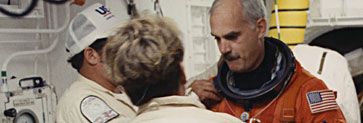
Starting out as a bench engineer and later serving for a decade as Director of Astrophysics, Dr. Charles (Charlie) Pellerin’s NASA career spanned nearly 30 years.
In 1975, Pellerin left his position as a principal investigator at Goddard Space Flight Center and transferred to NASA Headquarters. Eight years later, he was named Director of Astrophysics. During his tenure, he conceived of the “Great Observatories” strategy — four large contemporaneous telescopes spanning the observable electromagnetic spectrum.
Pellerin oversaw the launch of a dozen scientific satellites, including the Hubble Space Telescope. When a flawed mirror on Hubble prevented the telescope from performing, he launched a successful space repair mission for which he was awarded a NASA Outstanding Leadership Medal. Before retiring from the Agency in 1995, he also received NASA’s highest honor, the Distinguished Service Medal.
Since the time that the Hubble review board identified failed leadership as the root cause of the telescope’s failure, Pellerin began an intensive inquiry into the effects of social factors on project success. As a consultant to NASA, accounting firms, and aerospace companies, he has developed a “four-dimensional” approach to measuring and improving the effectiveness of project leadership, project culture, and organization interfaces.
Would it be fair to say that since leaving NASA you have focused your career on trying to understand why projects fail?
Yes, on why projects fail around social issues and around leadership — because I saw this same thing coming up again and again.
Can you explain what you mean by “social issues,” and how they relate to leadership?
I was the Director of Astrophysics at NASA between 1983 and ’92. I had a lot of flight projects going on, perhaps as many as 20 at any one time, and I would try to watch and pay attention to them all. That was my primary job, I thought.
I began to see a pattern repeated far too often when a successful project manager would get promoted or leave a project for some reason. I would replace him with someone who looked just as good on paper, but three months later, all of a sudden, the project started to fall apart. Milestones got missed. Reserves depleted too fast.
I was frustrated that I couldn’t anticipate and recognize the difference between project managers who were going to succeed and project managers who were doomed to fail. We could predict things like sensor performance. We could understand the detectors. We could understand the power systems. But we couldn’t understand this one critical, invisible piece: What makes a good manager?
So, I pondered this. I read books and thought about it a lot, but I got very little insight.
Was it the magnitude of the Hubble telescope problems, launching it with a flawed mirror, which brought this all to a head?
Yes, exactly. If you go back to what was happening at the time, we launched Hubble in 1990 and very soon thereafter we found that a technical person had made an error. At first we thought, “Now at least we know what the error was. We can figure out how to fix it.” And that’s just what we did — we fixed it. This would appear to be a very happy story for me; I got a NASA medal for the repair mission.
That’s all well and good, but then I said, “Wait a minute. We should have had systems in place to find this kind of thing.” The procedures are written. The engineers sign them. Safety & Quality Assurance stamps it all to verify that this is being done properly along the way.
Hubble was the final straw for me. I needed to understand what had happened, because when I looked around me I realized it was commonplace. I mean, take a look at Challenger. It was not, in a sense, a technical failure. It was another human communications failure. I knew a bunch of those people. They were damn good managers and engineers, but they got caught in a story. They created an environment where it wasn’t safe to tell the truth.
That’s interesting how you describe it as people who got “caught in a story.” How do stories figure into this leadership quotient?
The stories that you carry affect how you make decisions in your life. That’s why I’m very interested in the stories we tell. We all perceive reality through the filter of the “stories” we believe. We create stories to make sense of our experience. And, we act within this context as if it were truth, because to each of us it feels like truth.
I collect and study the impact of organizational and personal stories. Here’s an example: An entire American industry clung to their long-held story that “Improving quality means higher cost” until they had lost over 60% of domestic market share to a foreign industry. I am speaking, of course, about the automotive industry.
Similarly, it’s fascinating to help projects discover some of the stories they carry with them. They tell stories about their contractors, managers tell stories about scientists and vice-versa.
What kind of story did you tell when you were Director of Astrophysics?
The primary story that drove me, for good or bad, when I was Director of Astrophysics was that “We have a perishable opportunity here.” Never in the history of man had anyone invested what we were investing in astronomy.
If you added up all of the ancillary support, like the Shuttle launches and the civil service manpower I didn’t have to pay for, I probably had $2 to $3 billion per year to look at stars. I told people, “This is never going to happen again in our lifetime, and we’re going to make the best of it. If you’re not dedicated to giving your very best to it every day, go to work someplace else because this is a privilege and opportunity we have.” That was the story I told at that time.
What was it like to work for you?
You’d have to ask the people who worked for me, I suppose. I tried to be fair and not to confuse “toughness” for “meanness,” but there were certainly people who were uncomfortable in my division. I had a reputation for being tough. I remember that during one performance appraisal, a boss said to me that I would do better if I could “suffer fools gladly.”
I can recall people who joined the division who said, “You’re not the son of a bitch that people say you are. You are actually a great guy to work for.” I said to them, “Well, don’t ever tell anybody. I want people who like to work for SOBs to come here.”
It was this simple. If you shared my story, you would be comfortable. If not, you wouldn’t. I recall one hire who believed “Headquarters would be a nice place to ease into retirement.” He didn’t last long in the Astrophysics Division.
What are some of the other stories that you’ve told?
I have lots of them. As Howard Gardner says, “Leaders achieve their effectiveness chiefly through the stories they relate.” Here’s one: A day’s work for a day’s pay. This was often said to civil servants during Lyndon Johnson’s presidency. The variation I used with my staff went something like this: At the end of the day, I want you to stop at some small house outside the Capital Beltway, preferably one with a car in front that’s worth less than my titanium bicycle. Go inside and tell the people what you did during the day and what you were paid. If they agree that they got good value for their tax dollars, then you’re doing good work. If you can’t imagine passing that test, you should work elsewhere.
Here’s another one: When I was in college and running out of money, my roommate and I started a monogrammed sweatshirt business. We made a ton of money in four months. That was what mattered at the time. But the story I learned over the years is that making money is easy. What we need to focus on is making a contribution, and that’s a lot harder.
Closely related is another story I carry with me: Those who love you deserve a life of service in return. And, you know, I tell my wife every day that I live in service to her, but I don’t think she fully buys it.
What kind of stories are you telling now?
My main story (now) is that “unknown and unnamed” social undercurrents are at the root of many, if not most, project difficulties. These can be defined, measured, and remedied. Helping NASA projects do this is the most important contribution I can make with my life now.
You said that leadership was at the core of the Hubble mishap. Do you find evidence of this in other projects?
Sure. Diane Vaughn, in her book The Challenger Launch Decision, said she was a year into her study before she realized that then-accepted accounts of what happened were wrong. Vaughn concluded that the disaster was caused by an “incremental descent into poor judgment.” And she went on to say that the technical risks grew out of social issues. Notice the word “social” again. She realized that signals of potential danger had been repeatedly “normalized.” That was okay in the context of the stories their culture supported.
And that’s not the only example. Administrator O’Keefe cited similar language during recent testimony on the Columbia disaster. Art Stephenson, following the back-to-back Mars failures, said that success begins with leadership and forming a culture where people are permitted to succeed.
How are you trying to address these issues in your work with APPL today?
We have been developing a leadership/culture assessment and learning system called “Four-Dimensional (4-D) Leadership” since 1995. We began with workshops, and then added coaching, and now have Web-based diagnostics customized for NASA projects. Simply put, we make three measurements in each of the social dimensions — directing, visioning, relating and valuing—that we believe are fundamental to effective leadership and efficient cultures.
In a Web-based survey that only takes about 10 to 15 minutes to fill out, we ask respondents about observed behaviors such as mutual respect, trustworthiness, clear roles, and responsibilities. We review the data with the project manager (our “customer”) and the leads for each of the project teams. If the numbers for leadership or culture effectiveness are too low, we use a combination of workshops, telephone coaching, and consulting to improve performance. Then we re-measure and track progress.
Does it work?
Project managers tell us it does. We’re in the process now of working with projects at Goddard, JPL, and Ames, and our database of validated metrics is growing by the day.
We believe that we’re not far from having conclusive data that these systems work and that dramatic reduction in project failures, minor and major, are within our grasp. I’m talking about preventing high-profile failures like the Hubble mirror — but just as important are the less-visible performance shortfalls, budget overruns, and project terminations that managers and teams experience every day.
I truly believe that we can identify and address the root cause of most project difficulties. That’s my story. And many of the projects I’m working with are choosing to run that story as well — because they see results.
You know, no story is “good” or “bad.” Some just get you the results you want and some don’t.








